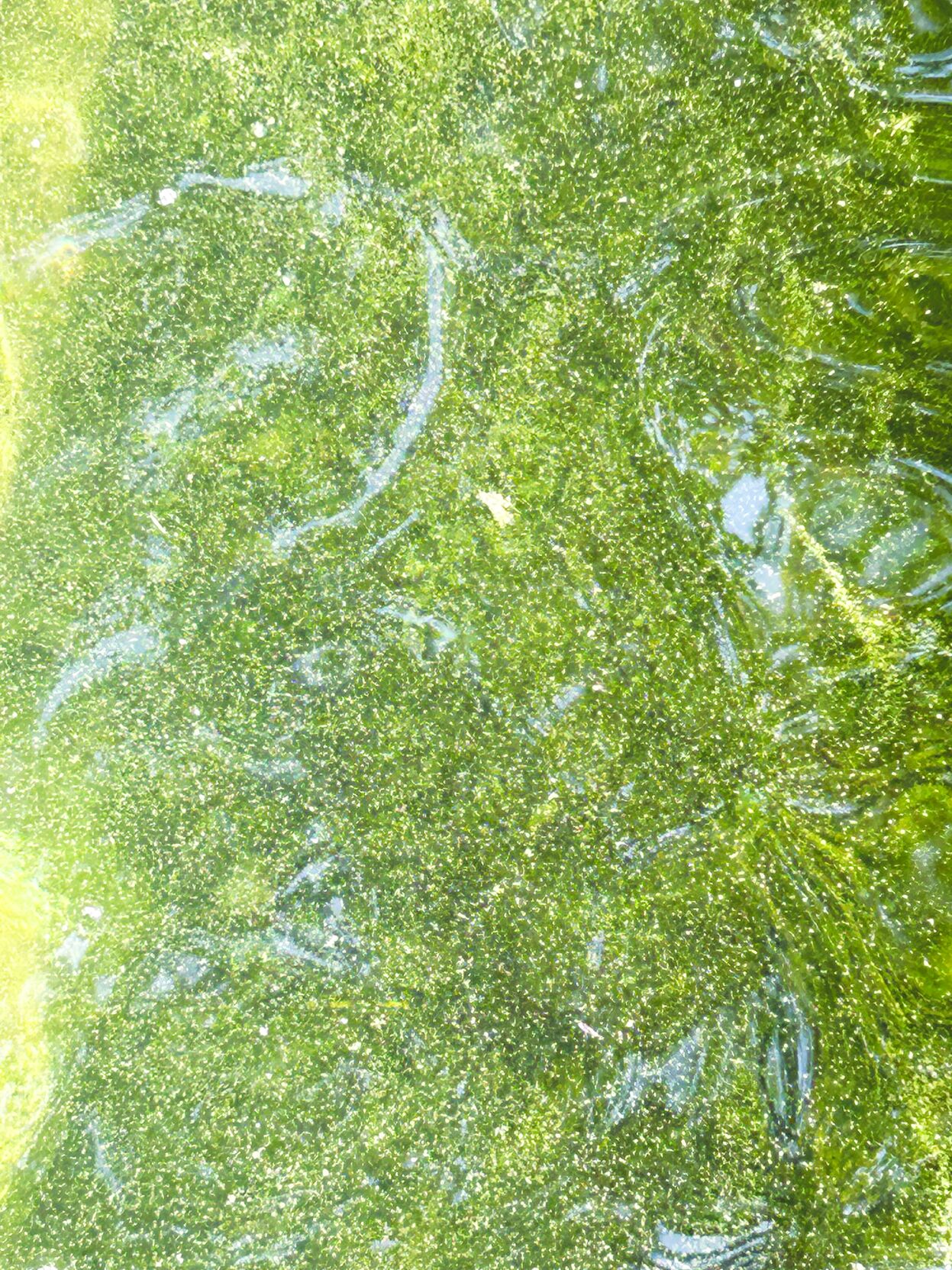If you’ve been out on Lake Winnipesaukee recently, you may have noticed tiny yellow-green spheres drifting just under the surface. This is Gloeotrichia (glee-oh-trick-ee-ah), a type of cyanobacteria that appears most often in mid- to late- summer when the water is warm and calm. It has been documented in Winni for decades, but it’s worth paying attention to because under certain conditions it can accumulate in numbers that may pose a health risk to people and pets.
Gloeotrichia colonies are about the size of a pinhead, fuzzy in appearance, and suspended a few inches below the surface and/or throughout the water column. On calm, sunny days they can give the water a faintly speckled, “starry night” look or at higher densities with more of a “galaxy” appearance. In some cases they collect in greater numbers along shorelines, appearing as green or yellowish clouds or streaks. While not all Gloeotrichia produce toxins, the possibility means it is important to monitor and report what you see.
Cyanobacteria, including Gloeotrichia, are not invaders, they are one of the oldest life forms on Earth and a natural part of a lake’s ecology. Along with other phytoplankton, they use sunlight to photosynthesize, producing oxygen and creating organic matter that supports the base of the aquatic food web. In healthy numbers, they help sustain life in the lake.
While many types of cyanobacteria can form dense surface blooms, Gloeotrichia more often remains suspended in the water column, sometimes building up enough to prompt potential health risk. These events can reduce water clarity, deplete oxygen in extreme cases, and, if toxins are present, pose risks to people and pets.
According to NHDES, “Exposure occurs through ingestion, inhalation or skin contact. Symptoms of exposure to cyanobacteria vary but can include skin irritation, stomach cramps, vomiting, nausea, diarrhea, fever, sore throat, headache, muscle and joint pain, mouth blisters, and acute liver damage. Long-term exposure can harm the liver and central nervous system.”
Gloeotrichia has a unique life cycle compared to many other cyanobacteria. It begins its growth in the sediments at the bottom of the lake, where it can store nutrients like phosphorus. As the summer progresses, it produces tiny gas vesicles that allow it to rise into the water column. This vertical migration is unusual and is part of why Gloeotrichia is often found in deep, clear lakes like Winnipesaukee, Sunapee, and Moosehead. Once suspended in the water, colonies may remain scattered or, if conditions are right, accumulate in coves or near shorelines.
On Winnipesaukee, the Lake Winnipesaukee Alliance works directly with the New Hampshire Department of Environmental Services to investigate reports, collect samples, and have them analyzed. NHDES counts cells and determines whether to issue a warning. A cyanobacteria warning is issued when samples are collected and concentrations exceed the state threshold of 70,000 cells per milliliter. This is displayed as a red icon on the state’s Healthy Swimming Mapper and means people and pets should avoid contact with the water in that area.
If cyanobacteria are present but below the threshold, NHDES may issue a watch, which appears as an orange icon and signals that people should use caution. Black triangles on the map represent observations, unconfirmed reports where cyanobacteria have been sighted but not sampled.
Because conditions can change quickly, results from sampling may not always match what you see at your shoreline or while recreating. NHDES recommends that everyone make a personal risk assessment before entering the water. If the water is discolored, cloudy, or contains dense accumulations of specks or streaks, the safest choice is to stay out and keep pets out. Reports from the public are critical to getting a location on the mapper.
If you see something unusual, take clear photos, note the location and time, and submit it through the NHDES Bloom Report Form online. Additionally, you can also call or text the Lake Winnipesaukee Alliance at 603-619-8703 and we can coordinate sampling with NHDES if needed.
Your observations, combined with ongoing monitoring, help protect water quality and ensure Lake Winnipesaukee remains healthy for both recreation and the countless species that depend on it. In a lake as large and dynamic as Winni, having many eyes on the water is the key to catching changes early, understanding them, and responding in time so lake users can make informed choices for themselves.
•••
Bree Rossiter is the conservation program manager for the Lake Winnipesaukee Alliance. She manages the water quality monitoring program, cyanobacteria monitoring initiatives, the Winni Blue/LakeSmart program, and assists with watershed management planning efforts. Bree can be reached at brossiter@winnipesaukee.org. The Lake Winnipesaukee Alliance is a nonprofit dedicated to protecting the water quality and natural resources of the lake and its watershed. To learn more, visit winnipesaukee.org.



















(0) comments
Welcome to the discussion.
Log In
Keep it Clean. Please avoid obscene, vulgar, lewd, racist or sexually-oriented language.
PLEASE TURN OFF YOUR CAPS LOCK.
Don't Threaten. Threats of harming another person will not be tolerated.
Be Truthful. Don't knowingly lie about anyone or anything.
Be Nice. No racism, sexism or any sort of -ism that is degrading to another person.
Be Proactive. Use the 'Report' link on each comment to let us know of abusive posts.
Share with Us. We'd love to hear eyewitness accounts, the history behind an article.